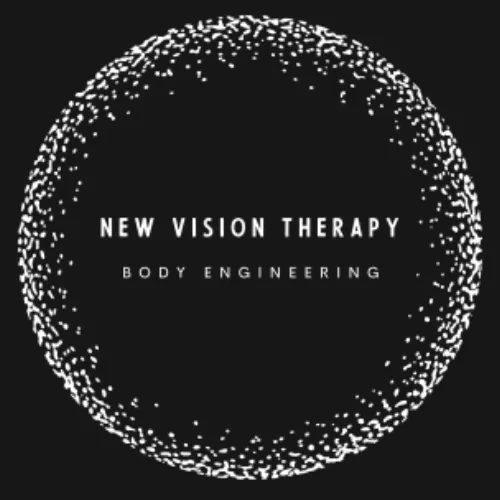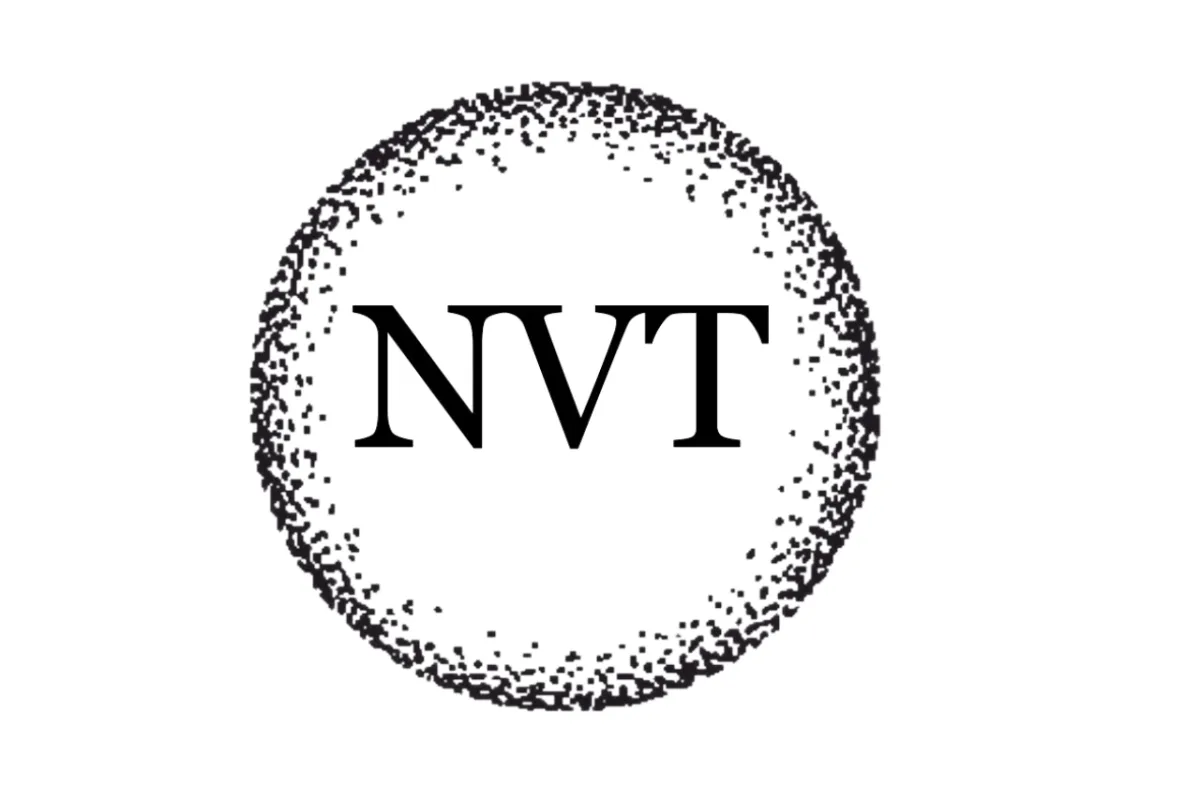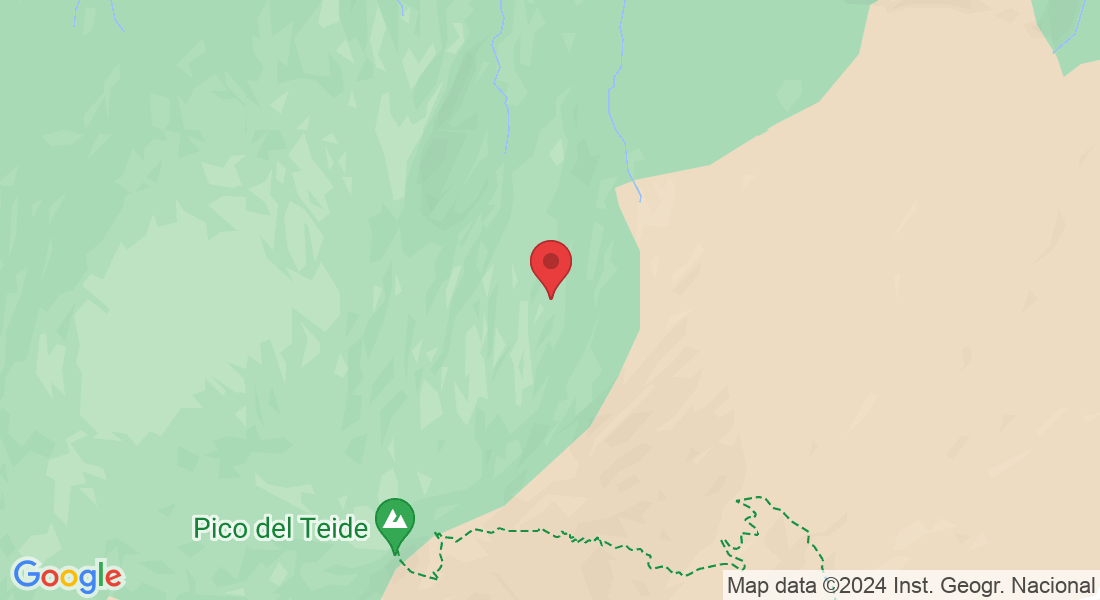Clinical Evaluation
In-depth clinical evaluations and studies that make New Vision Therapy possible
Abstract
Objective
To evaluate the effectiveness of
New Vision therapy (a combination of Upledger CranioSacral Therapy and powerful acupressure points) in a wide variety of presenting conditions that were either medically un-diagnosable or were not responding as hoped to conventional medical approaches.Methods
A randomly selected group of clients with a wide variety of presenting conditions were treated a maximum of 3 times at approximately 3 week intervals, and their symptoms were evaluated pre and post treatment.Results
86% of all clients treated reported significant reduction in their pain levels, as well as increased energy levels and a greater feeling of general wellbeing within 1 to 3 treatments.
Conclusions
Upledger Cranio Sacral Therapy used in conjunction with powerful acupressure points alleviated or eased many symptoms that were either medically un-diagnosable or were not responding as hoped to conventional medical practices.
Introduction
“The nervous system controls and co-ordinates all organs and structures of the body” Gray's Anatomy. This statement from the medical journal Gray's Anatomy sums up the purpose of our treatment protocols. New Vision Therapy is a gentle, safe and non-invasive neurological approach to body work focusing on releasing restrictions that are having a negative influence on the performance of the central nervous system. This study aimed to prove the efficacy of New Vision Therapy with a wide variety of presenting conditions that often had no clear medical diagnosis available, or where the patient was not responding as hoped to conventional medical approaches. New Vision Therapy is a combination of Upledger CranioSacral Therapy, used in conjunction with powerful acupressure points. Upledger CranioSacral Therapy works within the accepted principles of modern medical science, and works directly to enhance the production and absorption of cerebrospinal fluid in and around the central nervous system. This gentle yet powerful therapy forms the foundation on which this study was based. The brain and spinal cord create electrical signals that are conducted around the body. We consider this to be the “main energy highway” of the body, with the acupuncture meridians from Traditional Chinese Medicine being the smaller roads branching off from the main highway. In this way, enhancing the function of the central nervous system by clearing restrictions that are having a negative influence on its balanced performance releases energy into the meridians. These energy pathways can then be balanced as required to improve performance of individual organs or systems within the body. The purpose of this evaluation study was to try and prove the efficacy of New Vision Therapy with a wide variety of presenting conditions. Many of the symptoms treated were medically un-diagnosable, or were not responding as hoped to conventional medical treatments.
A Brief History of Upledger CranioSacral Therapy
‘’CranioSacral Therapy was pioneered, developed and structured by osteopathic physician Dr John E. Upledger. Early in the 1970s, during a surgery on a patient’s neck, Dr Upledger was fascinated to observe the distinct, regular movement of the dural tube (the tough membrane that surrounds and protects the spinal cord). Curious as to whether this movement had previously been investigated, he discovered the work of William Sutherland, who had developed Cranial Osteopathy. Dr Sutherland worked with a rhythm of the head but his claims that the sutures were moveable was queried by other osteopaths. At the time there was an organisation called the Cranial Academy and they asked Dr Upledger to do some research into whether or not this was what was really happening. So began his 8 years at Michigan State University, collaborating with a team of scientists, where he served as a clinical researcher and Professor of Biomechanics. During his time there he did show that the tissue in the suture differs from the tissue of bone and that the structures within this could allow for very small amounts of movement. He also researched what was happening between his hands and the client during treatments and was able to show that there is a transfer of energy and a change in electromagnetic frequencies that can be measured; he was able to gain a greater understanding of some of the key aspects of this cranial work and found that many problems previously thought to be confined to the head can in fact have primary causes elsewhere in the body. Dr Upledger’s subsequent research in this field led him to feel that while the Cranial Osteopaths were working with the alignment of the bones, these bones were also ‘slaves to the fascia’, that is, the dural membranes that attach firmly to the inside of the head and then continue down the spinal column. So the techniques he adapted and developed enabled release of restrictions and tension patterns not only in the bones but in the membranes below. Since the nerves that exit the cranium and spinal cord are also surrounded by fascia that is a continuum of the membranes, any tensions and issues in the rest of the body can affect the dural tube and craniosacral system. Hence we have techniques that treat the rest of the body too. In those years and since then, Dr Upledger developed the methodology to treat these membranes, and the body in relation to them. Because this was different from what the Cranial Osteopaths were doing he began calling it CranioSacral Therapy instead. He wrote the first text in 1983 and followed up with another four key text books and a few more easier readers for the lay person over the years, as he expanded and refined his approach to this work and treated and taught thousands of people. Then people wanted to know what he was doing… Why? Because of the results he and others he had trained were getting with patients.
The Upledger Institute
So, in 1985, as more and more people were clamouring to know what it was he was doing when he worked, he opened the Upledger Institute to format his teaching. The Upledger Institute began as a clinical and educational training centre in Palm Beach Gardens, Florida. He also taught a lot of other people to teach as more and more people around the world wanted to be able to learn how to utilise these techniques. There are now satellites all round the world and teachers and practitioners in over 100 countries. ‘’ (Ref 1) Dr Upledger was described by The Times magazine in 2000 as “one of the next wave of innovators”.
A Brief History of Acupressure
What is Acupressure?
Acupressure or acupoint massage is one of the most ancient and powerful therapies associated with Traditional Chinese Medicine (TCM). It is based upon the traditional theories of Qi, or Chi which is natural healing energy distributed around the body through energy pathways called meridians. There are thousands of acupoints along these meridians which are powerful junctions that can be stimulated with light touch to enhance the flow of energy through these pathways. By stimulating and enhancing the energy flows through these meridians, the visceral organs and muscle groups served by them will be properly regulated and balanced, promoting greater health, vitality and wellbeing. In China, as well as many other parts of the world, these methods are adopted to not only treat disease, but also as a powerful preventative.
Origin and development of the acupressure points
More than two thousand years ago the use of acupoints was widespread in medical practice within China. According to texts dating back through many Dynasties, acupoints have been used in combination with herbs and alcohol to address many health issues.
The theory behind Acupressure
In the Ming and Qing Dynasties massage had further developed and there were thirteen specialist branches into which medicine was divided. Since the founding of the People’s Republic of China in 1949, massage therapy has had rapid progress. Massage departments, massage clinics, massage hospitals, massage schools, massage faculties in colleges of TCM – Traditional Chinese medicine, as well as massage research institutions have been set up.
‘
’Acupressure / Acupoint Massage is a kind of external treatment based on the theories of Qi, blood, visceral organs, meridians and collaterals.
Meridians and collaterals are distributed throughout the body. They connect with the visceral organs (the heart, liver, spleen, lung, kidney, stomach, large intestine, small intestine, urinary bladder, gall bladder, and triple heater / energizer) internally and extend to the body surface skin – muscles, bones, limbs and orifices (eyes, ears, nostrils, mouth, urethra, vagina and anus), making all parts of the human body a coordinated integrity.
Nutrient substances such as Qi, blood and fluid are transported to various parts of the body chiefly through the meridians and collaterals to maintain normal body functioning. Meridians and collaterals are not only the connections in which the Qi and blood flow; they are also important approaches for reflection of pathological changes and transmission of therapeutic effect. By the way of meridians and collaterals, disorders or pathological changes of internal organs may be reflected at the body surface, while diseases of the superficial tissues may influence the visceral organs.
Therefore, disorders of the meridians and collaterals, either due to impact of emotional factors (excessive joy, anger, melancholy, anxiety, sorrow, fear and fright) or due to attack of exogenous pathogenic factors (wind, cold, summer heat, damp, dryness and fire), will lead to impaired flow of Qi and blood, and hence disease.
Method
Based on the above-mentioned theory, Acupressure / Acupoint Massage is performed on the principle of integrating mobilization with immobilization, treating the disease in accordance with an overall analysis of the patient’s condition and reinforcing what is in deficiency and reducing what is in excess by applying special manipulation and various forces directly on the Acupoint’s and meridians. So it has the action of promoting the flow of Qi and blood in the meridians and collaterals, improving the mobility of joints, invigorating the function of the spleen and stomach, recuperating the kidney ~ yang, causing sedation, smoothing the flow of the liver ~ Qi, warming the meridians and collaterals, dispelling wind and cold, removing blood stasis and swelling, softening and resolving hard masses.’’ (Ref 2) 102 consultation forms were sent to random new clients at our centre with a wide variety of presenting conditions. The initial consultation form was completed prior to the first treatment and contained information on the presenting conditions. This information included the effects on the client both physically and emotionally, other Healthcare professionals seen, pain scores and how the symptoms had influenced the client’s energy levels and sense of general wellbeing. In order to prove how effective the treatments can be, we set stringent parameters and the results attained were achieved within 1 to 3 sessions. The initial consultation and treatment would last for an hour and a half, with follow up sessions 1 hour if required. Intervals between sessions generally ranged from 3 to 4 weeks. At the end of the clients treatment programme, they then completed a follow up form indicating how the presenting conditions had changed since our intervention. In total 93 completed pre and post treatment consultations were returned, and these form the basis of the study.
Results
Results of the evaluation study are as follows.
Client Base
Graph 1.1 shows that of the 93 clients treated, 25 were male and 68 were female. The average age of the clients was 46.
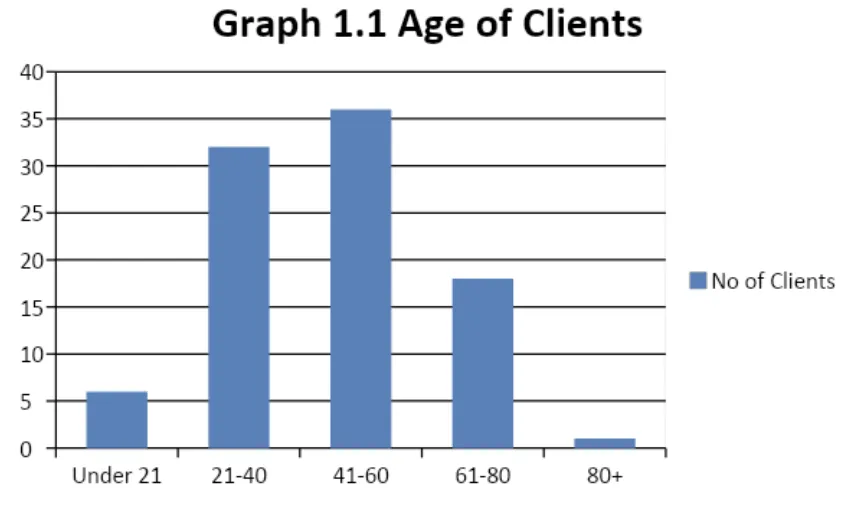
Presenting Conditions Pre-Treatment
Graph 1.2 shows a comprehensive list of the presenting conditions from the consultation forms filled out prior to the first treatment. The most common presenting conditions were bad back, neck and shoulder issues, fatigue syndromes, joint issues, headaches and migraines, and IBS and stomach disorders.

Other Healthcare Professionals Seen By Clients
Graph 1.3 shows a list of other healthcare professionals seen by clients previous to our intervention. GP’s were the most frequently visited, followed by chiropractors, physiotherapists and other specialist hospital consultants.
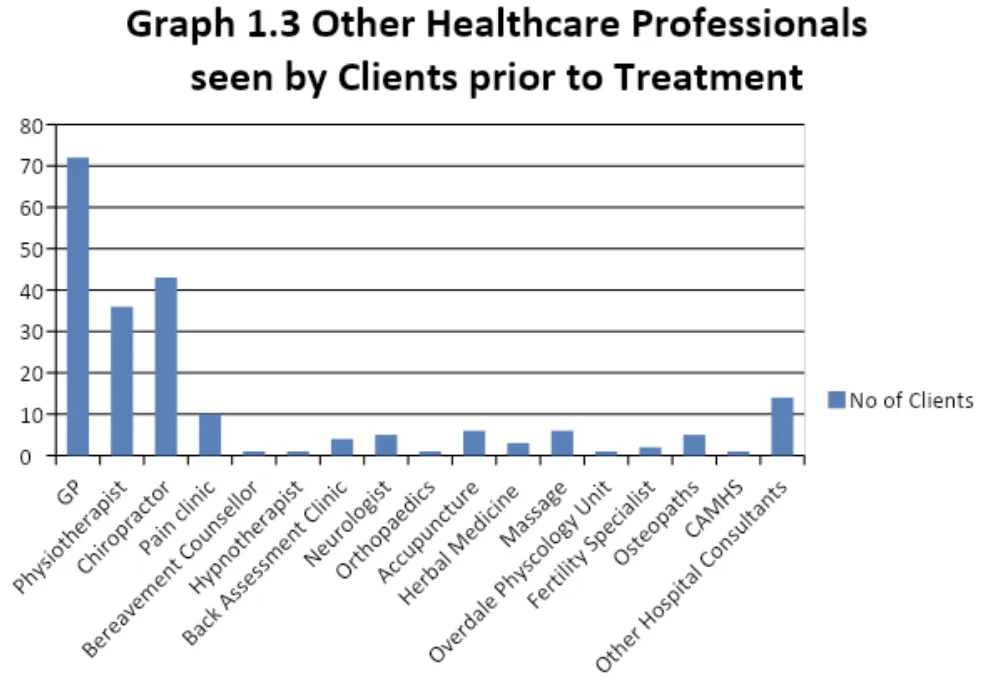
Did Presenting Conditions Prevent Physical Exercise
Graph 1.4 shows the impact on physical exercise as a result of the presenting conditions. Physical exercise refers to sports, climbing stairs, carrying shopping etc. The majority of clients felt that their presenting conditions affected their ability to carry out physical exercise slightly – moderately.
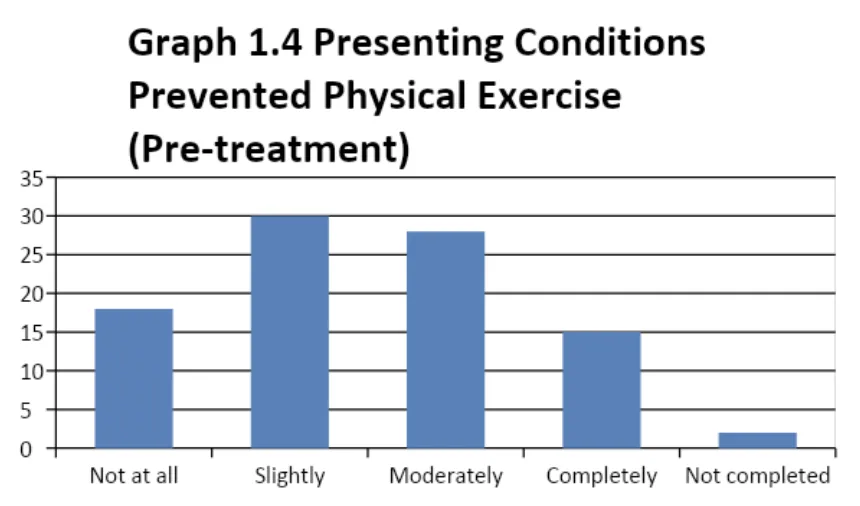
Ability To Carry Out Physical Exercise Post-Treatment
Graph 1.5 shows the ability of clients to carry out physical exercise post-treatment. 67% of the clients were completely able to carry out physical exercise post treatment.
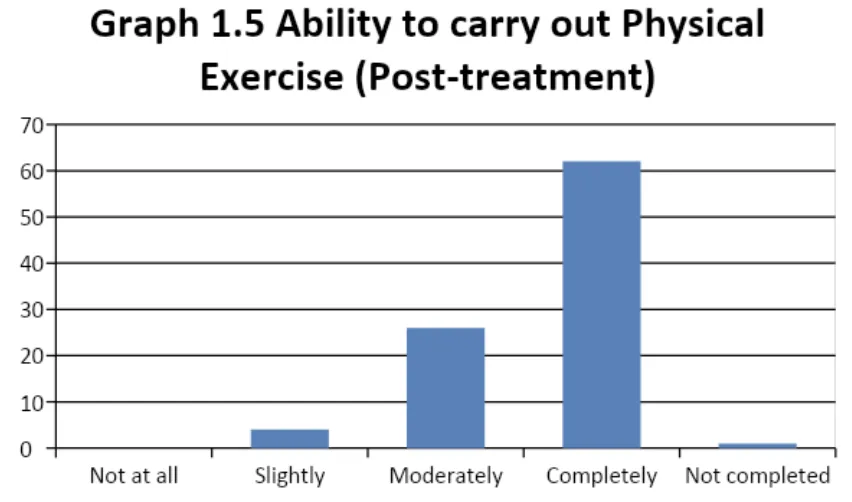
Did Presenting Conditions Prevent Moderate Physical Exercise Pre-Treatment
Graph 1.6 shows the impact on moderate physical exercise as a result of the presenting conditions. Moderate physical exercise refers to walking, housework, hovering, ironing etc. The majority of clients felt their presenting conditions affected their ability to carry out moderate physical exercise moderately.
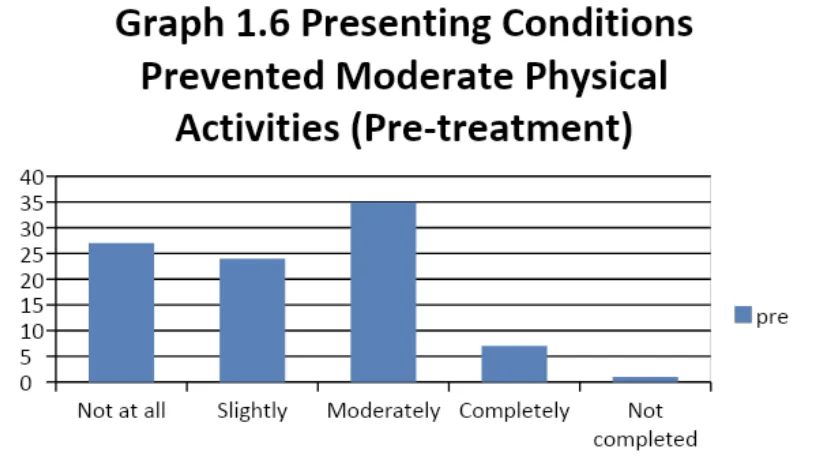
Ability To Carry Out Moderate Physical Exercise Post-Treatment
Graph 1.7 shows the ability of clients to perform moderate physical exercise post-treatment. 74% of the clients were completely able to perform moderate physical exercise post-treatment.
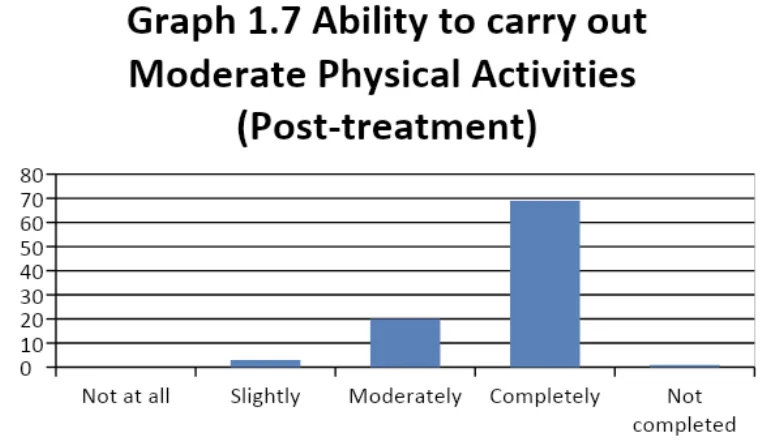
Did Presenting Conditions Prevent The Client Performing Daily Activities At Home Pre-Treatment
Graph 1.8 shows the impact on being able to undertake daily activities at home as a result of the presenting conditions. Daily activities at home refer to dressing yourself, washing yourself etc. The majority of clients felt their presenting conditions affected their ability to perform daily activities at home not at all.
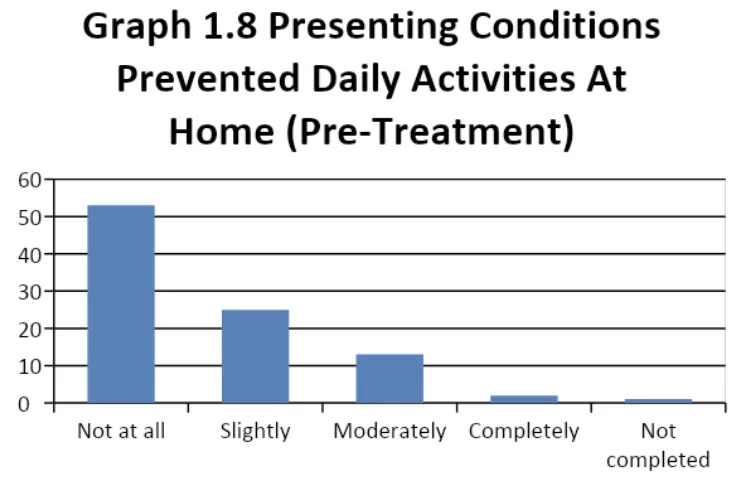
Ability To Carry Out Daily Activities At Home Post-Treatment
Graph 1.9 shows the ability of clients to perform daily activities at home post-treatment. 91% of all clients were completely able to undertake daily activities at home post-treatment.
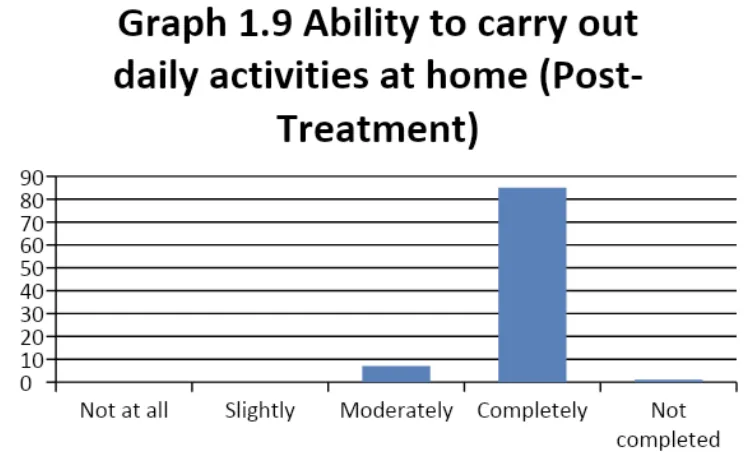
Did Presenting Conditions Prevent The Client From Participating In Social Activities Pre-Treatment
Graph 2.0 shows the impact on participation in social activities as a result of the presenting conditions. Social activities refer to going out, being with friends and family etc. The majority of clients felt their presenting conditions affected their ability to participate in social activities not at all.
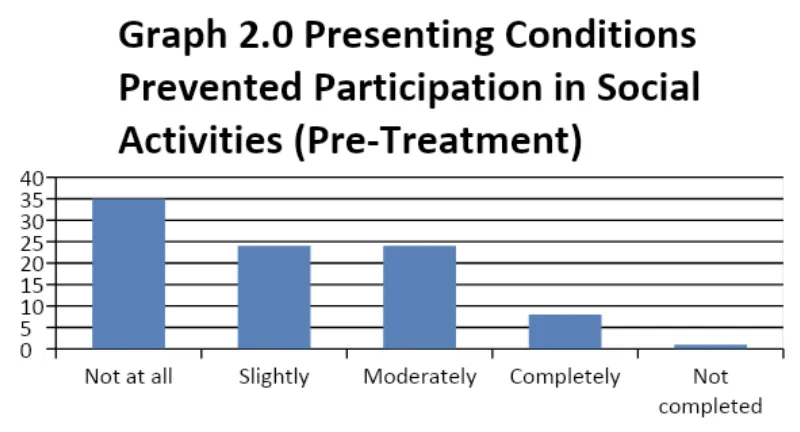
Ability To Participate In Social Activities Post-Treatment
Graph 2.1 shows the ability of clients to participate in social activities post-treatment. 73% of all clients were completely able to participate in social activities post-treatment.
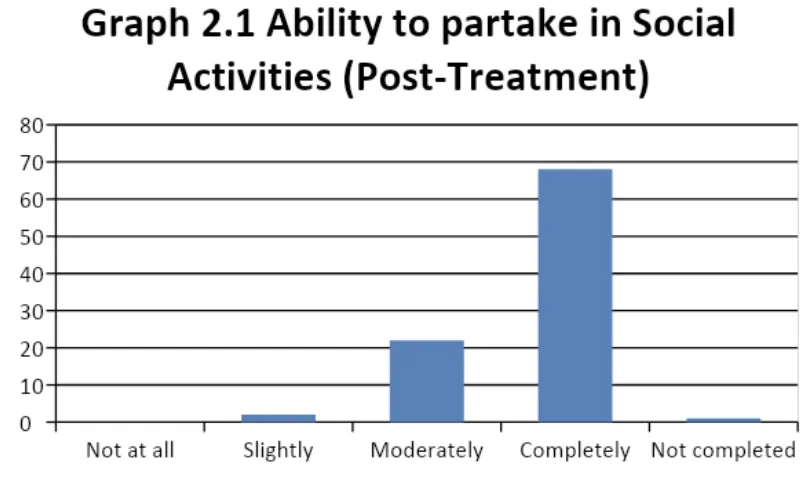
Did Presenting Conditions Cause Stiffness Pre-Treatment
Graph 2.2 shows the level of stiffness felt by the client caused by the presenting conditions. The majority of clients felt their presenting conditions caused moderate stiffness.
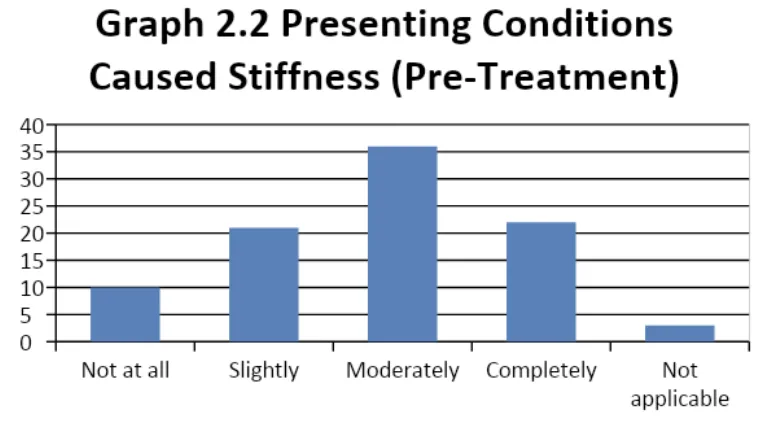
Improvement In Stiffness Post-Treatment
Graph 2.3 shows the improvement in stiffness felt by the client post-treatment. 54% felt their stiffness improved moderately, with 31% feeling their stiffness had completely improved.
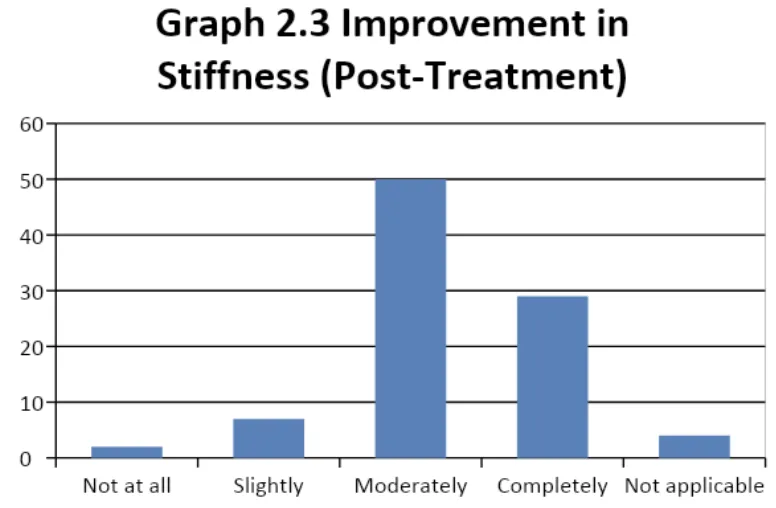
Did Presenting Conditions Limit Range Of Movement Pre-Treatment
Graph 2.4 shows the restrictions felt in their range of movement caused by the presenting conditions. The majority of the clients felt their presenting conditions affected their range of movement moderately.
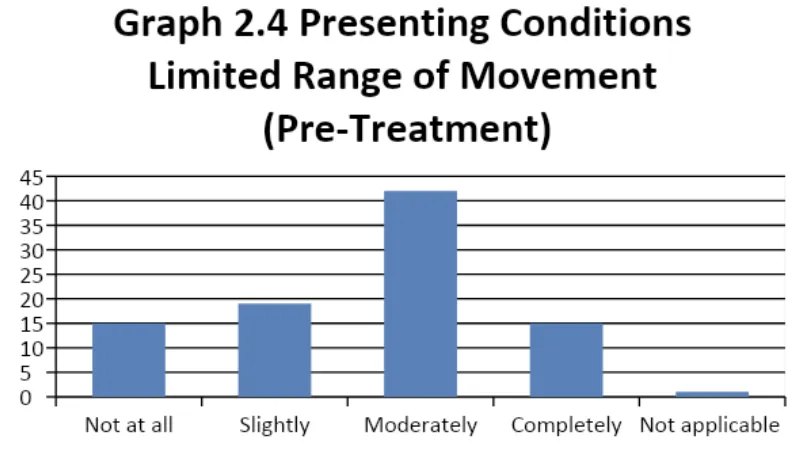
Improvement In Range Of Movement Post-Treatment
Graph 2.5 shows the improvement felt by the clients in their range of movement post-treatment. 45% felt their range of movement improved moderately, with 38% feeling their range of movement had completely improved.
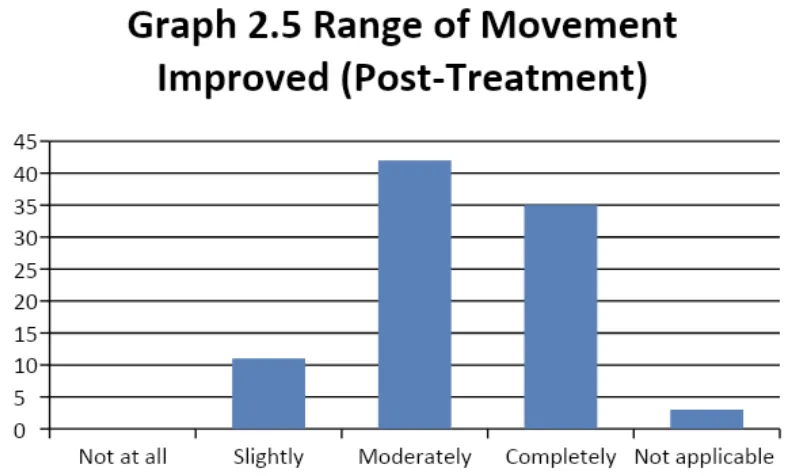
Pain Scores Felt By The Client Pre And Post-Treatment
Graph 2.6 shows the pain scores felt by the clients due to their presenting conditions pre and post-treatment. 0 = no pain, 1-3 = annoying but mild pain, 4-6 = moderate pain, 7-9 = severe and disabling pain and 10 = as bad as you can imagine. 79% of all clients felt their presenting conditions caused pain scores between 3-10 pre-treatment. Post-treatment 86% of clients felt their pain scores had dropped from 0 – 3.
Graph 2.6 – Pain Scores Pre and Post Treatment
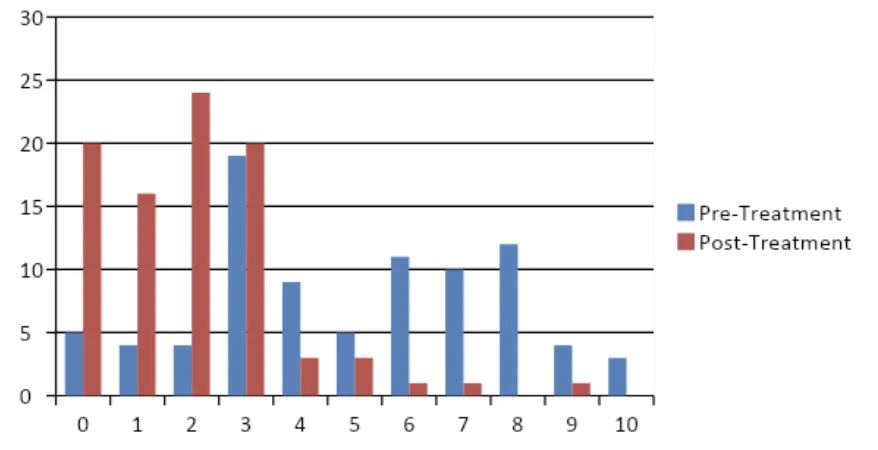
Energy Levels Felt By Clients Pre And Post Treatment
Graph 2.7 shows the general energy levels experienced by the client’s pre and post-treatment. Pre-treatment the majority of clients felt their energy levels were the same as normal. Post-treatment 68% of all clients reported feeling higher energy levels.
Graph 2.7 – Clients Energy Levels Pre and Post Treatment
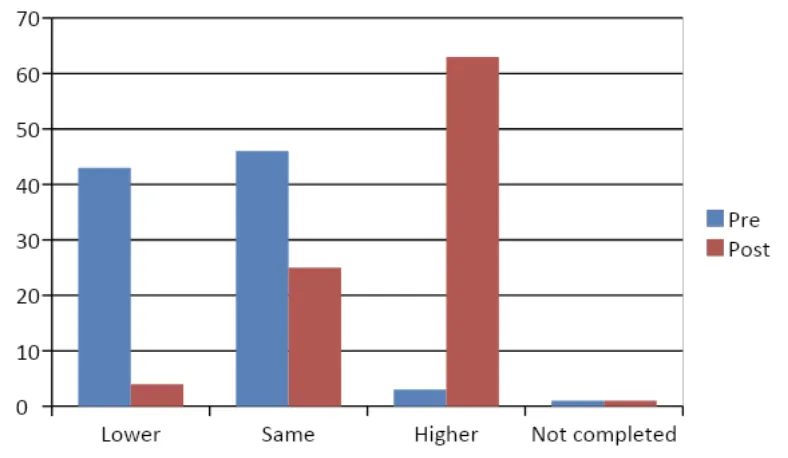
General Feeling Of Wellbeing Experienced By Clients Pre And Post-Treatment
Graph 2.8 shows the general feeling of wellbeing experienced by the clients pre and post-treatment. The majority of clients rated their feeling of wellbeing as fair pre-treatment. Post-treatment the majority of clients reported their feeling of wellbeing as very good.
Graph 2.8 – Clients General Wellbeing Pre and Post Treatment

Clients Rating Of New Vision Therapy
Post-treatment, the clients were asked to rate their experience of New Vision Therapy on the following scale: Very poor, poor, fair, good, very good and excellent. Graphs 2.9 and 3.0 show that 96% of all clients rated their experience as either excellent or very good.
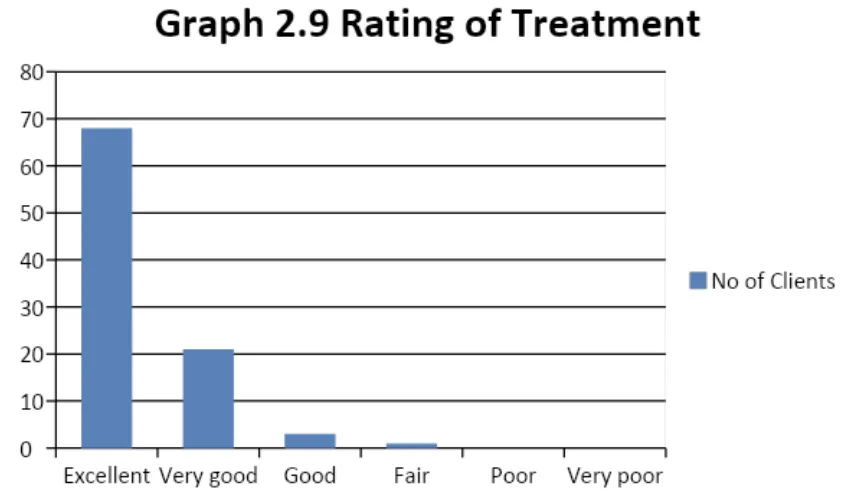
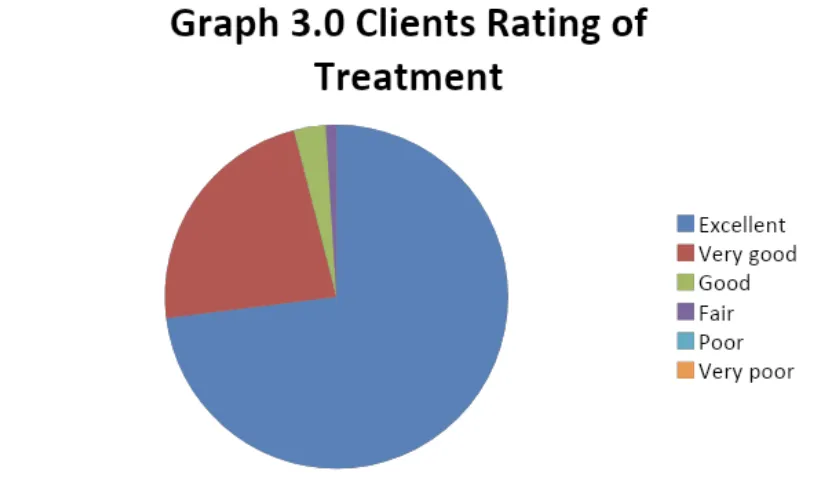
Discussion
New Vision Therapy uses a combination of state of the art, science backed therapies used in conjunction with ancient knowledge that our ancestors have been using for thousands of years. Most conventional medical practitioners would agree that despite all the amazing things that it can achieve, modern medicine has two main failings. Firstly, it often treats the symptom and does not address the underlying root cause, and secondly modern medicine is often restrained and limited by its diagnostic capabilities. For example, if a patient has a presenting condition and yet nothing shows on x-rays, scans or blood tests, then formulating an accurate science backed treatment programme for that person becomes impossible. How can you scientifically treat someone when you don’t know what the problem is? At this stage it can become nothing more than guesswork, based on the clinician’s interpretation of the symptoms on that given day, and his or her own personal experience. I am sure you will agree that this situation is far from ideal. Our Therapy attempts to help bridge this gap, by offering a more accurate diagnosis not necessarily on what is wrong with the patient (we leave medical diagnosis to the medical community) but what is not right. For example several seemingly unrelated symptoms may have a common root cause. An example of this might be IBS or stomach discomfort and neck/shoulder pain. There may seem to be no apparent connection here, and yet if the vagus nerve and cranial nerve XI are impaired at the base of the skull at the jugular foramina, this scenario could account for both the seemingly unrelated symptoms. Ultimately, if we cannot address the root cause, then all we will ever achieve is to fire fight the symptoms. Acknowledging the earlier statement from Gray's Anatomy that “the nervous system controls and co-ordinates all organs and structures of the body”, does it not then make sense that to be able to directly work with restrictions that are negatively influencing the central nervous system gives us the best possible chance of actually dealing with the root cause? We understand that any neurological release is reprogrammed and integrated by the central nervous system within 10 seconds. This would seem to back up our own experiences of many clients who sense almost immediate changes with their symptoms even during the course of a treatment. Treat the root cause, help get the nervous system working in a more natural and balanced manner, and the body can then be in a better position to fix and heal itself. This is obviously a far better proposition in the long run. So the objective of the therapy is quite straight forward – make sure all the simple things are in place in order that the body can then go on and undertake all the hard tasks by itself. We are not suggesting for one moment that our therapies are there to replace conventional medical wisdom – this is about promoting a more integrated approach to Healthcare, and working together in the best interests of the patient/client. A prime example of this is China – one of the most technically advanced countries in the world. Despite this, Chinese hospitals still adopt a combination of both modern medicine and Traditional Chinese Medicine (TCM) working hand in hand alongside each other. A gap in one area of expertise is filled by knowledge from the other – integration of both skill sets. I also feel that’s it very important to mention one critical fact. Using the simple, safe, non invasive methods that we do to work directly with the central nervous system can do no harm. The same unfortunately cannot be said for experimental medication that is often prescribed when no clear science backed diagnosis is available, which can often aggravate the underlying issues even more.
Analysing The Results Of The Study
Our client base was made up of 93 clients – 68 female, 25 male with an average age of 46. We deliberately set out to treat a wide variety of different presenting conditions in order to try and prove that by working directly with the central nervous system, many of the associated side effects of the original imbalance will often resolve themselves without any direct work once the root cause had been addressed. Graph 4.2 highlights the broad spectrum of symptoms presented. Again, it is important to state again that many of these presenting conditions had no clear clinical diagnosis available. Indeed 11% of the clients treated had been referred to Pain management specialists in order to learn to live with their conditions, as the medical community could no longer offer any hope that they could resolve the presenting conditions. The results attained by our intervention with all client’s was strictly limited to a maximum of 3 therapeutic sessions. This was done in order to try and prove how quickly the body can shift back towards a state of balance if the root cause is addressed.
Had the Presenting Conditions Prevented the Client From Performing Physical Exercise?
Graph 4.4 shows that 46% of all client’s felt that their pre-treatment symptoms had either moderately or completely prevented them from performing physical exercise. Graph 4.5 shows that post treatment 67% of all clients felt that they could now undertake those same tasks completely, with 95% stating that they could either moderately or completely undertake physical exercise after the treatment plans. 16% of all clients felt that their pre-treatment symptoms prevented any form of physical activity. Post treatment not one client felt that this was the case anymore.
Had the Presenting Conditions Prevented Moderate Physical Activities?
Graph 4.6 shows that pre-treatment 8% of all clients felt they could not perform any type of moderate physical activity, with 45% stating that their presenting conditions prevented them from performing these tasks moderately or completely. Post-treatment, graph 4.7 shows that 96% of all client’s felt that they could now perform moderately or completely these same activities, with no client now feeling that their symptoms prevented any form of activity.
Had the Presenting Conditions Restricted Daily Activities at Home?
Graph 4.8 shows that pre-treatment 2% of all clients felt their symptoms prevented them from performing these daily tasks at all, and 16% felt it hindered them moderately or completely. Graph 4.9 shows that post-treatment 99% of all clients now felt able to undertake these tasks completely or moderately, with no client now feeling unable to do any of them.
Had the Presenting Conditions Prevented You From Enjoying Social Activities?
Graph 5.0 shows that pre-treatment 9% of all clients felt their symptoms prevented them from participating in social activities at all, with 34% feeling moderately or completely unable to undertake social activities. Post-treatment graph 5.1 shows that 97% of all clients now felt able to participate in social activities completely or moderately, with no client now feeling unable to participate at all in these activities.
Had the Presenting Conditions Cause Stiffness?
Graphs 5.2 and 5.3 show the levels of stiffness felt by the client’s pre and post-treatment. 62% of clients felt that their symptoms left them feeling moderate to completely stiff in their bodies. Post-treatment 85% of clients felt their stiffness had completely or moderately improved, with only 2% of clients stating that their stiffness felt the same post-treatment.
Had the Presenting Conditions Limited the Clients Range of Movement?
Graphs 5.4 and 5.5 show the effects on clients range of movement caused by their presenting conditions. 61% of clients felt that their symptoms had either completely or moderately affected their range of movement. Post-treatment 83% of these clients now felt that their range of movement had either moderately or completely improved.
Had the Presenting Conditions Caused You Pain?
Graph 5.6 represents the pain levels experienced by the clients due to their presenting conditions. This was based on a scale of 0 – 10. 0 was pain free and 10 was the worst pain you can imagine. Pre-treatment 79% of all clients rated their pain scores between 3 – 10, with 58% rating their pain as moderate to extreme. Post-treatment 86% of clients felt that their pain levels had reduced to either no pain, or annoying but mild pain, or a pain score 0 – 3. 22% of all clients said they were now pain free after their sessions with only 5% stating that they had no pain prior to treatment.
Had the Presenting Conditions Affected Your Energy Levels?
Graph 5.7 shows the effect on the client’s general energy levels caused by their presenting symptoms. Pre-treatment 46% of all clients reported having lower energy levels than normal due to their symptoms. Post-treatment only 4% of client’s felt their energy levels remained lower than normal, with 68% reporting much higher energy levels after our intervention.
Had the Presenting Conditions Affected Your Feeling of Wellbeing?
Graph 5.8 represents the effect on the client’s general feeling of wellbeing due to their presenting conditions. Pre-treatment only 1% of all clients reported feeling excellent, with 22% rating their feeling of wellbeing as poor or very poor. Post-treatment 58% of all clients reported feeling very good or excellent, with no clients rating their feeling of wellbeing as poor or very poor.
How Did the Client’s Rate the Treatment’s They Received at New Vision Therapy?
Graphs 5.9 and 6.0 represent how the client’s rated the treatment’s they had received at New Vision Therapy Centre. 96% of all those clients rated their treatment experience as either excellent or very good, with no client’s rating their experience as poor or very poor.
Conclusion
From the study that we undertook, it would appear to show that the vast majority of client’s treated experienced huge reductions in their pain levels, reduced levels of stiffness in their bodies, increased ranges of body movement, increased energy levels and a far greater sense of general wellbeing after their treatment programmes. The majority were again able to partake in more physical activities and to enjoy social events than they had been able to pre-treatment. 96% of all of those clients treated rated their experience of our treatments as either excellent or very good. Many of those people treated had long standing chronic conditions and had been on long term medication. Post-treatment many of those client’s were then able to either substantially reduce, or in some cases come off of their medication altogether. Only 4% of all client’s treated felt no major changes in their symptoms after 1 – 3 treatments. In summary, the purpose of this study was to evaluate how effective Upledger CranioSacral Therapy used in conjunction with powerful acupressure points can be in working directly with the central nervous system to help alleviate client’s conditions that had no clear medical diagnosis available or were not responding as hoped to conventional medical approaches. We believe this study confirms that indeed this safe, non-invasive approach has something very real to offer and should be working hand in hand alongside conventional medical wisdom in the best interests of the patient/client.
Funding
This research received no funding from any agency in the public, commercial or non profit sector.
References
Upledger UK website 2014
Melbourne College of Professional Therapists


